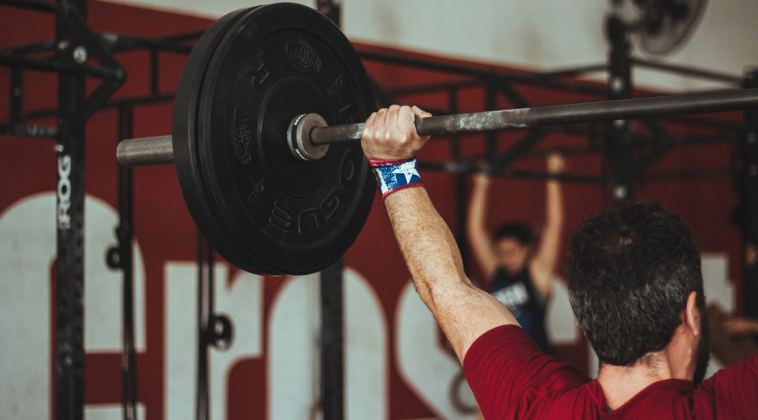- Like
- SHARE
- Digg
- Del
- Tumblr
- VKontakte
- Flattr
- Buffer
- Love This
- Save
- Odnoklassniki
- Meneame
- Blogger
- Amazon
- Yahoo Mail
- Gmail
- AOL
- Newsvine
- HackerNews
- Evernote
- MySpace
- Mail.ru
- Viadeo
- Line
- Comments
- Yummly
- SMS
- Viber
- Telegram
- JOIN
- Skype
- Facebook Messenger
- Kakao
- LiveJournal
- Yammer
- Edgar
- Fintel
- Mix
- Instapaper
- Copy Link
Photo by Victor Freitas on Unsplash
The best measure of absolute pressing strength is not the bench press (please don’t tell the powerlifters) but the overhead press. Although the bench press is pretty standard among lifters, the same cannot be said for the overhead press or the many overhead press accessory exercises.
Why? You get no assistance from the bench or a spotter yelling, ‘It’s all you, bro’ while they lift the weight for you. With the overhead press, it’s your feet on the ground, hands on the barbell, and either lift it—or not. The overhead press is all you, bro, making it arguably a better test of pressing strength than the bench press.
Here we’ll dive into what’s needed for an excellent overhead press technique, and seven coaches share their favorite overhead press accessory exercises for an improved overhead press.
Muscles Used For The Basic Overhead Press Exercise
There are certain deviations in form and technique when it comes to any lift because you’re all put together differently. But there are certain non-negotiables regarding the overhead press, and they are.
- Shoulder Mobility: If you cannot raise your arms overhead without pain or compensation from the back or anterior core, you have no business going overhead.
- Core Stability: A common mistake with the overhead press is the overarching lower back and the protruding ribcage to lift the barbell overhead. Having good core strength will help reduce crushing your lower back to smithereens.
- Triceps And Upper Back Strength: The final third of the lift is all triceps, and adequate triceps strength is needed to lock out your overhead press. For scapular stability, upper back strength is required to ensure a better pressing path and lockout.
This could go on a bit, but these three critical areas must be locked in before hoisting heavy weights overhead.
Overhead Press Accessory Exercises
These seven expert coach accessory exercises will point you in the right direction when you’re looking at improving your overhead press strength and performance.
1 of 7
Single-Arm Overhead Seated Z Press
From: Mike T. Nelson, Ph.D., a metabolism fitness professional, strength coach, and educator
Why I like it: No assistance from the lower body puts more focus on your pressing power while strengthening imbalances between sides.
How to do it: Sit flat with your legs straight out on the ground. Please use a kettlebell or dumbbell in 1 one and press overhead at a 45-degree angle out in front. Do not use your other arm to stabilize, as this will increase the use of your core muscles.
Programming suggestions: I like this as an accessory exercise. You can do with a heavier load in the 6- to 8-rep range, too, since you can’t press it overhead if you can’t stabilize, so it helps prevent you from going super heavy.
2 of 7
Pin Press
From: Andrew Heming, MS, C.S.C.S., N.S.C.A.-CPT trainer, professor, and former university head strength coach
Why I like it: Pressing from pins in a power rack is a very safe, very effective way to build powerful pressing strength where you need it the most.
How to do it: Set up in a power rack. You can be seated on a high incline or standing. Set the pins at your desired height, and this is based on where you want to build strength. Take a deep breath, grip the bar hard, and get your whole body tight. Focus on exploding the weight to lockout. Even if the weight doesn’t move fast, the intent explodes. Control the weight on the way down. Let the bar sit on the rack between reps after pausing on the pins. Take another deep breath, get tight, and power up the next rep.
Programming suggestions: Pin presses work best for lower reps and heavy weights. If you are using a partial range of motion, you can use heavier weights than your current full range of motion press—especially as you get used to the exercise. For strength, three to five sets of 3-5 reps, resting three minutes between sets. Plus, for muscle: three to four sets of 6-8 reps, resting two minutes between sets.
3 of 7
Prone Y Raise
From: Chris Cooper, strength and nutrition coach at Nerd fitness
Why I like it: Improving your overhead press isn’t solely about getting stronger in the pressing muscles like the delts and triceps. We have to consider a range of motion and shoulder stability as well. The Prone Y Raise targets the mid and lower traps as well as the muscles of the rotator cuff. All these are working together can put us in a better position to press overhead in a stronger and more stable position.
How to do it: Set your bench on a slight incline and lay on your chest. Grab your dumbbells and lift them in a Y motion to the ceiling until your arms align with your ears. Slowly lower them back down to the start. The dumbbells can be held either with your palms facing down or facing each other. Both are effective, but one might feel more optimal for your shoulders than the other.
Programming suggestions: This is not an exercise that requires much weight. More weight usually leads to using momentum rather than targeting the appropriate muscles. Start light and work on a range of motion and control with reps in the 10 to 15 range. A slight increase in weight or reps will be the way to go when you want to increase the difficulty.
4 of 7
Half Kneeling Kettlebell Press
From: Dan John, athlete, strength coach, educator, and author
Why I Like it: Most people get caught in this area where all presses are either on the back (bench press), on a seat (machine presses), or standing (military press and the overhead variations). The half-kneeling press forces the lifter to lock in the whole body to get the reps in.
How to do it: Position yourself in the half-kneeling position, ankle above knee and knee above hip. Squeeze your glute and “pull” your front heel toward your back hip for better stretch and tension. Clean the kettlebell to the rack position on the knee downside and press overhead until lockout. Slowly lower back to the rack position and reset and repeat.
Programming suggestions: It’s part of every routine I use…including mobility work. On road trips, I have people do light sets of the 20s, and for strength, sets of 8. I try to do these three times a week. There is some nice hypertrophy work for the shoulder, but the lift’s whole-body “health” can be a game changer for many of us.
5 of 7
Hex Bar Overhead Press
From: Detric Smith, trainer and owner of Results Performance Training
Why I like it: To get better with the overhead press, you need to press more, but the barbell can be unforgiving. The neutral grip of the trap bar is easier on your wrist and elbows, while this pressing variation focuses on your triceps more to assist with lockout strength.
How to do it: Set up the trap bar in the squat rack at around shoulder height with D handles up or down. This is a matter of preference. Step inside the trap bar and grip tightly with your wrist in neutral, and engage your glutes and anterior core Press with control until your elbows are locked out. Pause for a second, slowly lower back to the starting position, and reset and repeat.
Programming suggestions: This is a better exercise for added volume for muscle rather than strength. Three to four sets of 6 to 12 reps work well.
6 of 7
RNT Strict Press
From: Dr. Bo Babenko, a physical therapist and strength coach specializing in strengthening the mind, body, and soul
Why I like it: The RNT single-arm press can be attacked from multiple different angles of pull to activate a slew of different muscles. The shoulder complex has nearly 20 muscles that CAN help any upper extremity motion. When you perform an overhead press, you want to be able to recruit as many of these guys as possible.
No matter how hard you think you are pressing, there is usually more we can do, even if we find a way to get your serratus anterior to kick in another 3% or so… We use terms like “prime” the muscles frequently for lifts, but this is an excellent example of how that truly is put into practice.
How to do it: I prefer the half-kneeling position to activate your core and isolate the shoulder. Set the band up to pull you in any direction you want to work on, with the pull toward your body being best to activate more of the rotator cuff and abductors. But setting it to pull you posterior or anterior can be a unique challenge that will also pay dividends.
Programming suggestions: Fits best into a warmup on an upper body day. In general, 4-6 reps with slow, intentional movement per side for two to three sets is more than enough to wake many shoulder accessory muscles up to prime them for overhead pressing.
7 of 7
Tall Kneeling Upside Down Kettlebell Overhead Press
From: Raphael Konforti, senior director of fitness, YouFit Gyms
Why I like it: This exercise targets where most people are weak in the overhead press, shoulder girdle, and core stability. Many people have a large gap between the amount of weight they have the strength to overhead press and what they can overhead press. A perfect example is the amount of weight people overhead press on a plate-loaded machine versus a standing dumbbell overhead press.
A stronger overhead press requires strong shoulder stability with a stable foundation underneath the core. This is one of the few shoulder exercises where you will fail because you lose stability rather than strength. As an added perk, the positioning makes it difficult to cheat reps up by using the lower body. The smaller the difference between the weight you use on this exercise vs. standard overhead presses, the healthier and stronger your shoulders will be.
How to do it: Get into a tall kneeling position on your knees and toes and engage your glutes and anterior core. Grip the kettlebell bottoms up with the horn ‘sitting’ in the meat of your palm and wrist in neutral. Grip tight and press overhead until lockout, leaving your elbow underneath the kettlebell at all times. Slowly lower down until the KB is in front of your shoulder, reset, and repeat.
Program suggestions: Program this as your primary or secondary overhead press exercise. Start by performing 10 to 12 reps for 3-4 sets, then increase the weight and lower the reps to perform 6-8 reps for strength.
Success!
Thank you for signing up. Your information has been successfully processed!


